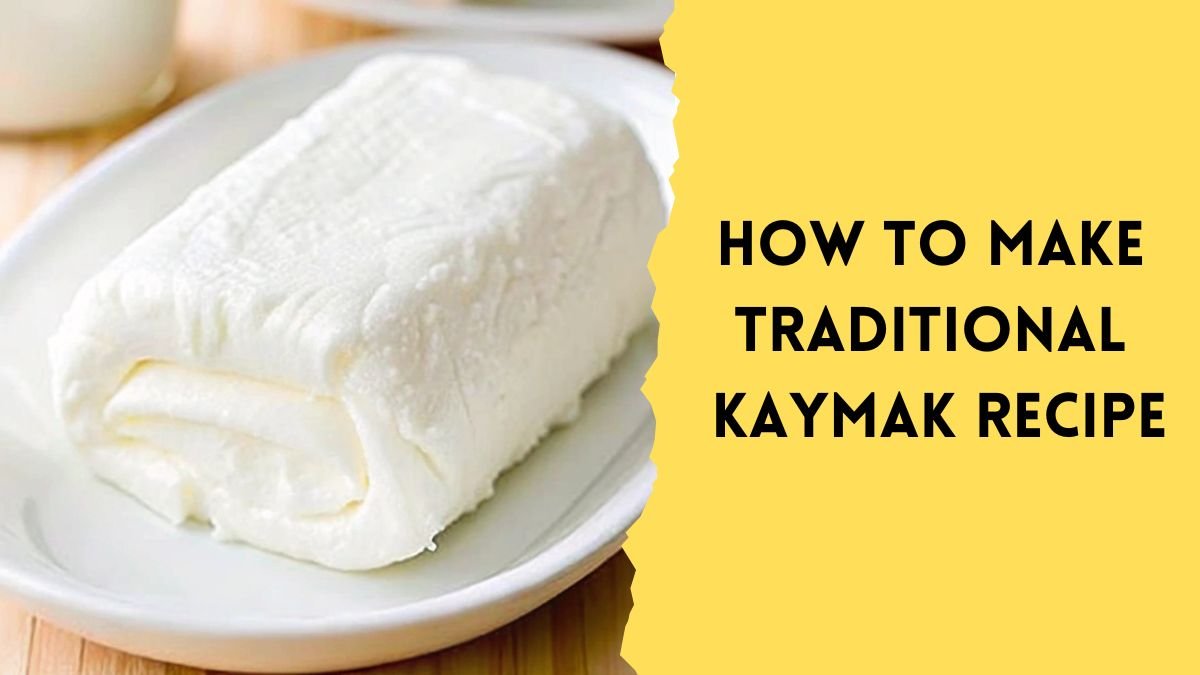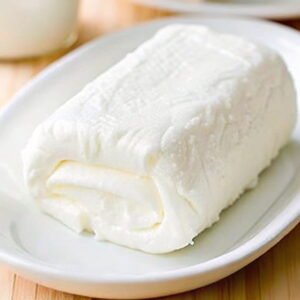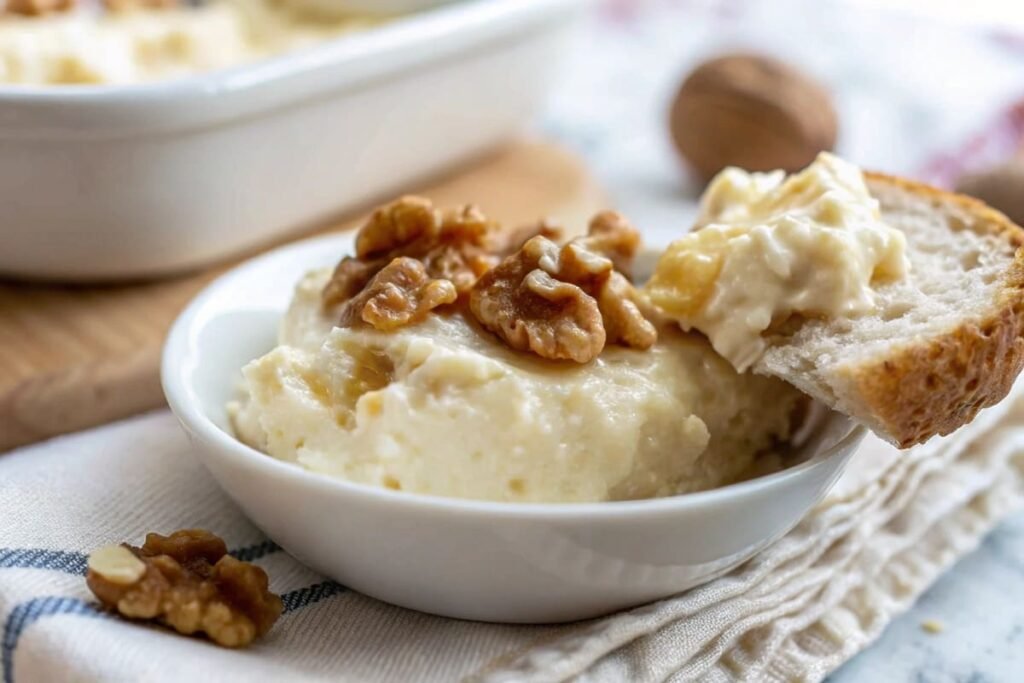Traditional Kaymak Recipe, Variations, Cultural Significance, and Culinary Uses
Learn to make Kaymak the traditional way, just as it has been crafted for generations in the Balkans and Caucasus regions.

Kaymak is a creamy dairy product similar to clotted cream, traditionally made from the milk of water buffalo, cows, sheep, or goats. It is characterized by its thick, velvety texture and rich, buttery flavor. According to Wikipedia, the word “kaymak” has its roots in Central Asian Turkic languages, possibly derived from the verb “kaymak,” which means “‘”to melt”‘” or “molding of metal”‘” in Turkic. The earliest written records of the term appear in the Dīwān Lughāt al-Turk by Mahmud al-Kashgari.
Kaymak is a staple in various cuisines across Central Asia, the Balkans, the Middle East, and parts of the Caucasus and South Asia. Its preparation and consumption have been deeply embedded in local cultures for centuries, reflecting the shared culinary heritage of these regions.
Kaymak Variations

The traditional method of making Kaymak involves a careful process of boiling milk and allowing it to cool slowly. As it cools, a thick layer of cream forms on the surface, which is then skimmed off and allowed to ferment slightly, enhancing its flavor and texture.
The primary ingredient in traditional kaymak is milk, often unpasteurized and unhomogenized, which allows for the natural separation of cream.
This beloved delicacy has inspired numerous regional variations, each with its own preparation techniques and unique characteristics, showcasing the diverse culinary traditions of the regions where it is made.
| Feature | Turkish Kaymak | Balkan Kajmak | Iraqi Geymar | Iranian Sarsheer |
|---|---|---|---|---|
| Traditional Name | Kaymak | Kajmak | Geymar | Sarsheer |
| Region | Turkey | Balkans (Serbia, Montenegro, Bosnia) | Iraq | Iran |
| Key Ingredients | Milk (often water buffalo milk) | Unpasteurized milk (cow, sheep, or goat) | Water buffalo milk | Milk |
| Preparation Method | Milk and cream boiled and simmered over low heat for several hours, cream skimmed and cooled repeatedly | Milk boiled, cooled, and cream fermented; sometimes matured in dried animal-skin sacks (e.g., skorup) | Milk boiled and left to cool, cream skimmed from the top | Made without heating the milk, preserving enzymes and cultures |
| Distinctive Features | Rich, creamy texture; often served with honey and bread | Tangy, rich flavor; thicker consistency; traditional aging process adds complexity | Thick, creamy consistency; typically enjoyed at breakfast with flatbreads and honey | Softer texture; slightly lighter flavor due to no heating process |
In this post, we’ll focus on how to make the traditional kaymak recipe, particularly as it’s prepared in the Balkans and the Caucasus region.
This time-tested method captures the authentic flavors and textures that make kaymak a cherished treat in these parts of the world.
Check Also: Goat Milk vs Sheep Milk vs Cow Milk: An In-Depth Comparison
Traditional Kaymak Recipe (Balkan Version)

Traditional Kaymak Recipe
Equipment
- 1 Shallow pan
- 1 Ladle
- 1 Mixing spoon
Ingredients
- 1 Liter Milk Whole milk recommended
- 750 grams Heavy cream Must be 35% milk fat
- 1.5 tbsp Salt Preferable Himalayan, Sea Salt or Celtic Sea
Instructions
Preparing the Mixture
- Boil the milk in a shallow pan for 5 minutes over medium heat.
- Pour the heavy cream into the pan from a height to create aeration. Aeration helps distribute the cream evenly and improve the texture of the kaymak. Stir gently to combine.
- Reduce the heat to low and simmer for 2 hours, stirring occasionally.
Cooling and Reheating
- Remove the pan from heat and let the mixture cool at room temperature for 7 hours
- Reheat the pan on low heat and simmer for an additional 30-40 minutes without stirring
Setting and Aging
- Let the mixture cool completely and refrigerate for 24 hours.
- Remove from the fridge, add the salt, mix thoroughly, and transfer the kaymak back to the refrigerator.
- Allow the kaymak to age for at least 2 weeks to develop a smooth, spreadable texture and a rich, tangy flavor.
Serving
- Serve chilled with warm bread, tea, or as a topping for desserts or savory dishes.
Notes
- For a sweet version, add honey or fruits like figs before serving.
- For a savory twist, mix in herbs like dill or spices like smoked paprika.
- Let the kaymak age longer if you prefer it firmer.
- Use fresh, good-quality milk and cream for better results.
- Don’t stir during the second simmer to keep the layers intact.
- Serve kaymak with roasted vegetables or grilled meats for a hearty meal.
- Keep it in a tightly sealed container to stay fresh longer.
- Try toppings like walnuts, pistachios, or a drizzle of olive oil for extra flavor.
Frequently Asked Questions
Nutritional Content and Health Considerations
Kaymak is a high-calorie dairy product, primarily composed of milk fat. A typical serving size of 30 grams contains about 150 calories.
It is predominantly composed of fat (92% of its macronutrient profile), with minimal carbohydrates and a small amount of protein. A 30g serving contains 15g of fat, including 10g of saturated fat, which is 50% of the daily value.
Given its high fat content, particularly saturated fat, kaymak should be consumed in moderation, especially by individuals managing cholesterol levels or those on a low-fat diet.
The high caloric density also means it can contribute significantly to daily calorie intake, which is a consideration for those monitoring their weight.
Serving Suggestions and Culinary Uses
Kaymak is a versatile ingredient used in various ways across different cuisines:
- Breakfast Accompaniment: Kaymak is often served as part of a traditional breakfast, paired with bread, honey, or jam. In Turkey, it is enjoyed with honey and honeycomb, making it a staple in Turkish breakfast spreads.
- Dessert Topping: It is frequently used as a topping for desserts, particularly with baklava and other Turkish sweets, enhancing their richness and flavor.
- Savory Dishes: While predominantly associated with sweet pairings, kaymak can also be used in savory dishes, served with roasted chicken or as a filling in pies.
- Common Pairings: Popular pairings include honey, fruit preserves, various types of bread and pastries, and fresh fruits or nuts.
- Cooking Ingredient: In some regions, kaymak is used in cooking to add richness to dishes, incorporated into sauces or used as a base for creamy soups and stews.
Cultural Significance
Kaymak is more than just a dairy product—it carries deep cultural importance in the regions where it is made and enjoyed. In Turkey, kaymak is a beloved staple of traditional breakfasts. It is often paired with honey, walnuts and fresh bread, creating a simple yet indulgent dish. It is also used as a luxurious topping for desserts like baklava, enhancing the flavors of these sweet treats.

In the Balkans, kaymak, or “kajmak,” is considered a culinary treasure, especially in Serbia, Montenegro, and Bosnia and Herzegovina. Here, it is not only a food item but also a symbol of regional pride and tradition. Its a versatile accompaniment to various dishes, from grilled meats to freshly baked bread.
In Afghanistan, the product is called “qaimak” or “qaymaq” and is a popular part of the breakfast table – just like Turkey. Typically served with bread and sweetened with honey or jam, it is both a comforting and celebratory dish, shared among families and guests alike.
The cultural reach of kaymak extends beyond its primary regions. Its influence can even be seen in the linguistic heritage of other cultures. For example, the Sinitic term “sū” in Chinese, which describes a creamy texture similar to kaymak, hints at the broader impact of this unique dairy product.
Final Words
Kaymak is more than a dairy product—it’s a delicious symbol of shared culinary traditions and cultural heritage. Its creamy texture and rich flavor make it a favorite in many regions, each adding its own twist to how it’s made and enjoyed. Whether you prefer it fresh or aged, paired with something sweet or savory, kaymak is a treat that brings people together.
Have you ever tried kaymak? If so, we’d love to hear about your experience! Share your favorite way to enjoy it or ask us any questions you have – we’re here to connect and explore this delightful tradition with you.
Check all our recipes here.
